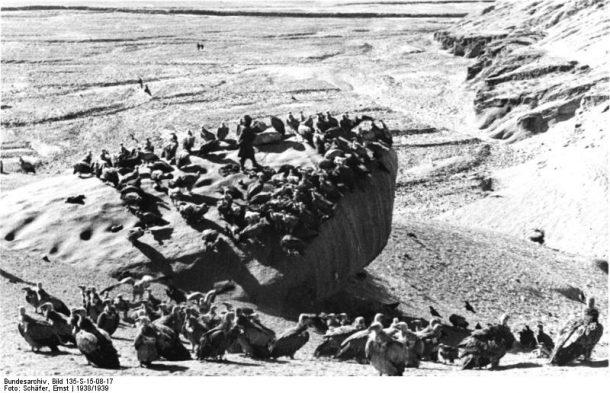Sky Burials: An Act of Compassion and Generosity

Vultures at a sky burial site. Bundesarchiv, Bild 135-S-15-08-17 / Schäfer, Ernst / CC-BY-SA 3.0
For many visitors, sky burials, the practice of dismembering corpses and feeding them to the vultures, seem to be at odds with their image of Tibet. In a land known for its beautiful mountains, staunch devotion to Buddhism and compassionate people, how could this seemingly brutal practice exist?
On the surface, watching a rogyapa, or “breaker of bodies,” hack the limbs off a corpse and smashing the bones into powder can be unpleasant. But in reality, sky burials are a direct reflection of Tibet’s geography, religion and its people.
While the rest of the world generally disposes their dead by burying them in the ground or cremating them, neither option is feasible for Tibetans.
Earth burials are extremely rare in Tibet simply because most of the time it’s just not possible. The surface layer of the Tibetan Plateau is no more than a few centimeters deep and beneath it is mostly composed of hard rock or permafrost. Where the surface layer is deep enough to dig a grave, earth burials are only used for people who have died from poison or communicable diseases.
Cremation on the Tibetan Plateau is also extremely difficult. As most of the plateau is above the tree line, firewood is scarce. Cremations are normally reserved for high-ranking religious teachers or “lamas.” Though with the introduction of new technologies, cremations are becoming increasingly popular.
With these two traditional funerary methods unavailable to them, sky burials emerged as the primary way of disposing the deceased. Besides its practicality, sky burials are used as reminders of the impermanence of life. Tibetans are often encouraged to witness a sky burial to confront their fear of the physical realities of death.
According to Tibetan Buddhism, the soul separates from the body at the moment of death, leaving behind an empty shell. Using the physical remains to sustain the life of another living thing is seen as an act of generosity and compassion, two tenets of Buddhism.
Once the physical remains of the deceased have been disposed of, more focus can be paid to the departed soul. In total, the soul is believed to traverse 49 days of bardo, the transitory state before the next incarnation. During this period, family members recite passages from Bardo Thodol, The Tibetan Book of the Dead, to help the soul navigate itself through this death journey to its next incarnation, or in some cases enlightenment.
Without context, the Tibetan practice of sky burials can be easily misunderstood. But beneath its gruesome exterior lies two virtues Tibetan people have come to be known for: compassion and generosity.
Recent Posts
Can Tourists Visit Tibet?
Exploring the Beauty of Tibetan Handicraft
The Ultimate Guide to Tibet Tours, Travel, and Trekking Adventures
All Categories
- About Tibet
- book a Tibet tour
- Buddhism Practice
- Budget Tour
- China-Tibet Train
- Customized Tibet tour
- Historical Sites
- Hot Springs in Tibet
- News
- Photography in Tibet
- Tibet attraction
- Tibet Group Visa
- Tibet Motorcycle Tour
- Tibet Small Group Tours
- Tibet Tours and Tibetan Tour Guide
- Tibet Train
- Tibet Travel FAQs
- Tibet Travel Information
- Tibet Travel News
- Tibet Travel Permit Update
- Tibet Travel Prices Rises
- Tibet Trek
- Tibet Trekking Tour
- Tibet weather and climate
- Tibet Wildlife animals
- Tibet Winter Tour
- Tibetan Buddhism
- Tibetan Cultural Features
- Tibetan Culture and Poeple
- Tibetan Festivals
- What to see in Tibet


